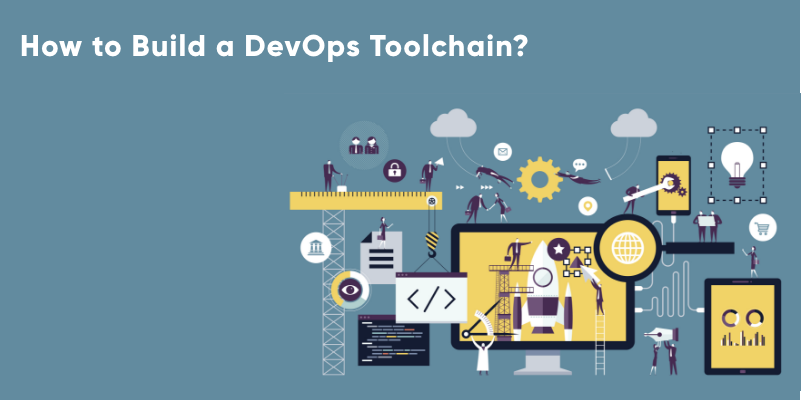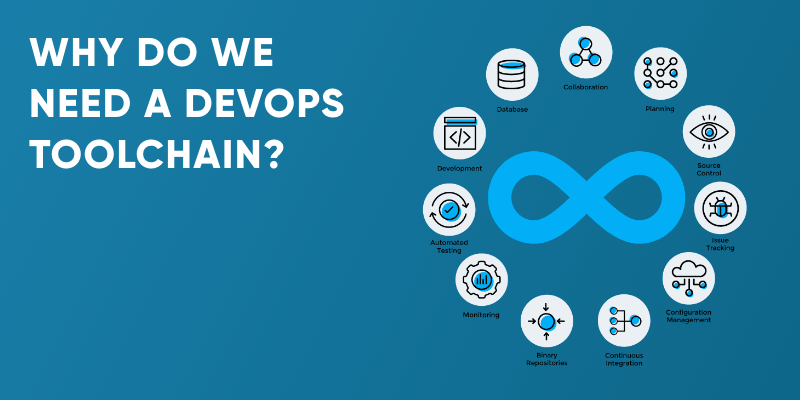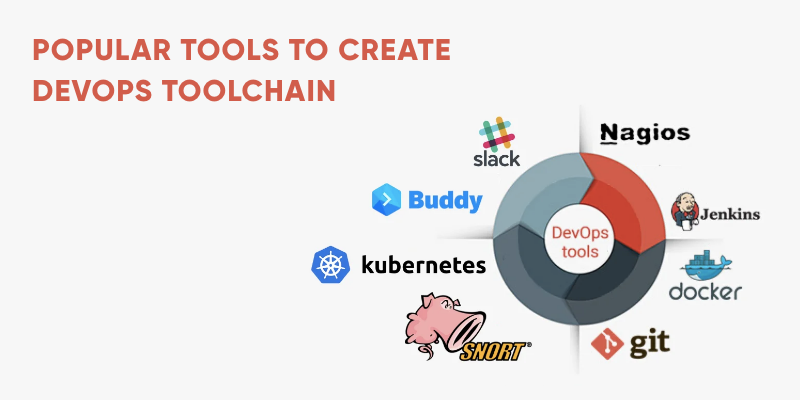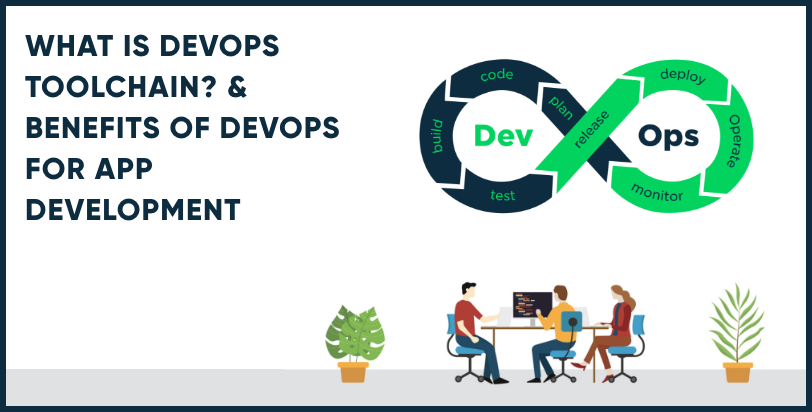Before we discuss the DevOps toolchain, let us first understand DevOps. Furthermore, DevOps is the next step in the growth of software development methods. It is more of a comprehensive way of thinking that organizations have to apply to get the best possible results. Ultimately, the aim is to break the barriers between different teams like development, and IT operations, and prompt them to communicate and collaborate even better.
As a matter of fact, they can develop and release a better product faster if their powers get together. It will be easier and quicker to deal with the problem with more effectiveness and reduced overall complexity.
“DevOps toolchain”, is a term that refers to the tools which a team uses. It’s used for ease in development, the management process of the product, and delivery. It is aligned with the organization’s DevOps culture and is more effective.
If you have a well-planned DevOps toolchain that is ideal for your requirements then it can help companies reach their goals and maintain an efficient software development process with the help of best software architecture patterns.
How To Build A DevOps Toolchain?
Two main approaches considered for the DevOps toolchain are named all-in-one and open source.

All-in-one Solution
It offers a completely functional development environment. It does not permit or need a third-party integration. A big aid to the firms that are just starting with DevOps. Incorporating a set of DevOps tools is a speedy and effective way to develop an app.
Open-source Solution
It is a customized toolchain as per the demands of the teams. Being open-source, it offers developers to use their existing tools and have a more comprehensive DevOps toolchain.
We provide collaboration tools for robust automation and rapid development, as we are a DevOps software development services company.
According to us, for developing a successful DevOps solution the incorporation of important tools plays a crucial role.
Why Do We Need A DevOps Toolchain?

DevOps toolchain automates various functional elements of your workflow. For a good strategic plan, various people are brought together. This will play a very important role to move the company forward.
Following are a few benefits of introducing the DevOps toolchain:
Budget and Time Optimization
Your business can save both its time and money by automating manual tasks. The budget is optimized by eliminating the extra cost that is caused due to poor time management or natural human mistakes.
Timely Incident Management
DevOps toolchain allows you to enhance your incident management record which is achieved by the DevOps toolchain by reporting IT incidents, providing them to the needed team members, and then following up until the issue is resolved.
Faster and More Efficient Product Deployments
DevOps tools automate the majority of the software development process. The company remains ahead in the competition by quickly creating new products and solutions.
Quality Assurance
Spotting software bugs quickly and with precision is a tough task. DevOps makes this task easy to fulfill. DevOps makes sure to deliver the best quality product as it is the most important selling point for most of the products.
Efficient Development
The process becomes more efficient with the DevOps toolchain. This is done by eliminating the unessential delays between different aspects of development work.
No one needs to wait for the other team member before taking over because the work is coordinated between front-end and back-end developers, and quality testers
Faster Deployment Means Higher Quality
To get a higher quality and faster deployment phase, the bugs should be addressed. DevOps toolchain makes sure to address these bugs easily and expertly. Personalized updates can be sent to your teams during major incidents.
Fine-Tuned Incident Controls
Humans are careless and take impulsive decisions so it is better and easier to trust computers. It becomes easier and more efficient for teams to respond during an incident if they are Using a centralized pipeline and infrastructure.
Benefits Of Developing An Application Using DevOps
DevOps toolchains can benefit an organization in several ways. Some of them are listed below-
Faster Deployment: The software development process is automated using the DevOps toolchain.
Incidental Control: Incident management is efficient because everything is managed using centralized pipelines and infrastructures.
Quality Assurance: DevOps toolchain offers quality software solutions.
Effective Development Process: The development process becomes more effective using the DevOps toolchain because it eliminates unnecessary development work.
Popular Tools To Create DevOps Toolchain

Your basic DevOps toolchain will have the following components. This could be a little different in some cases based on each team’s particularities, project requirements, team size, etc. Let’s discuss the most popular tools:
Issue Tracking
Increased openness results in better vision, making it simpler and faster to track issues. There are issue tracking tools available, but there is a requirement that all teams should be using the same tracking tool.
Some examples of issue monitoring apps are Jira, ZenDesk, and Backlog.
Collaboration
Collaboration and communication between different teams is the greatest catch of the DevOps culture. To automate the entire process of development, testing, and product management different teams work together.
Improved communication means faster software launches. Slack, campfire, and Skype are some examples of collaboration tools.
Planning
Stakeholders, clients, and employees working with various departments should all have the same goal. In the end, transparency among the participants is an essential factor.
Planning tools create this transparency. Asana and Clarizen are a few examples of planning tools.
Source Control
You require a centralized storage location for all of your records, documents, code, settings, files, etc. This source allows you to split data into separate branches so that teams can work on it.
Source control tools provide you the advantages of these features. Some examples of source control tools are Git, Subversion, and SVN.
Configuration Management
Wouldn’t it be great if your whole system was automatically configured and upgraded without you having to worry about it? This is where configuration comes to aid.
Different environments allows you to manage your infrastructure as code and prevent configuration drifts. Ansible, Puppet, and Chef are some examples of configuration management tools.
Continuous Integration
Wouldn’t it be great if your whole system was automatically configured and upgraded without you having to worry about it? This is where configuration comes to aid.
Different environments allows you to manage your infrastructure as code and prevent configuration drifts. Ansible, Puppet, and Chef are some examples of configuration management tools.
Binary Repositories
It’s conceivable that a product making is on a daily or hourly basis. A repository manager is a good way to bridge the gap between the developer’s machine and the environment as the code needs to flow smoothly.
Repositories contain all binary program objects, metadata, and code. Some examples are Artifactory, Nexus, and Maven.
Monitoring
Monitoring is a must in DevOps for smooth execution. It helps to make sure that services are accessible all the time and are of ideal performance.
Few examples of monitoring tools are BigPanda, Nagios, and Sensu.
Automated Testing
The entire integrated code needs testing before moving it to the creation. The faster the feedback loop runs, the faster you can achieve your goal.
Telerik, QTP, and TestComplete are some examples of automated testing tools.
Development
Development is another great concept of DevOps that enables the application deployment to be regular and stable. For releasing your product quicker to the market you can use the deployment tools.
Database
Finally, there comes managing the data. Each application development project needs a lot of data. Data plays an important role in getting insights. It becomes very easy to handle a huge amount of data with database management tools.
RazorSQL, and TeamDesk, are a couple of examples of database management tools.
Develop An App Using DevOps Toolchain
DevOps evolution increased by 62 percent in the higher stages of application development cycle in 2020. DevOps is all about making the development life cycle quicker, more automated, and collaborative.
You can concentrate on the development and then deployment of the project by leaving all your boring work like installing, upgrading, configuring, and setting up the infrastructure to the tools in the DevOps toolchain. You need to stay up-to-date in this competitive IT industry with the latest technology to deliver the best results.
Nowadays, since DevOps is in use almost at every place, it has become essential for you to understand its toolchain.
If you are looking forward and aiming at delivering high-quality software, Echoinnovate IT will be your one-stop solution. We as a DevOps consulting firm provide you with collaborative tools for robust automation and faster deployment along with the developing solution that produces real-time outcomes is our concern. Get in touch with us for hire DevOps Engineers for your next big project!
FAQs
What is the DevOps Scrum Method?
The DevOps scrum method is a method of the scrum that uses standard DevOps techniques to improve overall agility in a given business. It is a more thoughtful approach that focuses on overseeing operational teams, QAs, and product teams in a single cycle. It is an agile development framework that includes multiple Scrum features such as Product Owner, Web, Mobile, and QA that create Scrum of Scrum to deliver product facility to customers.
What are the different components in DevOps implementation?
Complex and fragmented development pipeline: Unlike pure-play, IT, streamlining team formation and workflow at the endpoints of multiple application distribution, including web, mobile, and devices, is very challenging.
Treating the “environment” as a code: Product development will require the virtualization of multiple devices associated with the server infrastructure. The concept of ‘Infrastructure as Code’ in IT needs expanding towards giving the whole ‘environment as code’.
Supporting Legacy Devices and Solutions: Production with Cloud Infrastructure brings the requirements for operating, updating, and maintaining existing devices in the field with newly added devices, resulting in increased diversity and complexity for DevOps.
Publishing Cadence: Developing an integrated publishing plan becomes a challenge with many solution components including firmware, web application, mobile application, and PC applicatio



